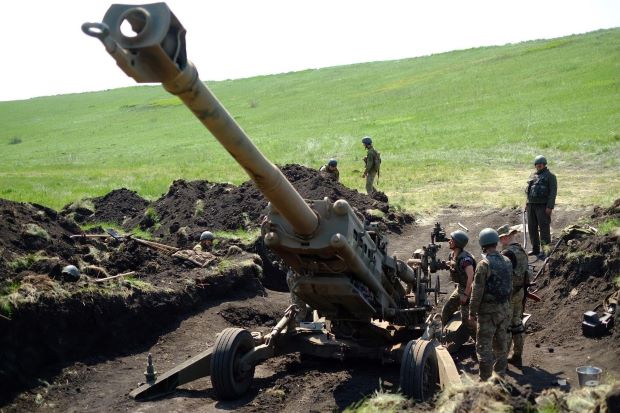American heavy artillery enters the fight in Ukraine
By Andrew E. Kramer and Maria Varenikova
POKROVSK, Ukraine — Camouflaged in a heap of branches cut from nearby trees, the weapon that Ukraine hopes will make a critical difference in its war with Russia is all but invisible from more than a few feet away.
Soon, a single round shoots out with a boom and a howling, metallic shriek as it sails toward Russian positions.
It is the American-made M777 howitzer. It shoots farther, moves faster and is hidden more easily, and it’s what the Ukrainian military has been waiting for.
Three months into the war in Ukraine, the first American heavy artillery — the most lethal weapons the West has provided so far — are now deployed in combat in Ukraine’s east. Their arrival has buoyed Ukraine’s hopes of achieving artillery superiority at least in some front-line areas, a key step toward military victories in a war now fought mostly on flat, open steppe at long ranges.
The American howitzers are chunky machines of steel and titanium swathed in hydraulic hoses and perched on four braces that fold up and down. They have already fired hundreds of rounds since arriving around May 8, destroying armoured vehicles and killing Russian soldiers, Ukrainian commanders say.
“This weapon brings us closer to victory,” Col. Roman Kachur, commander of the 55th Artillery Brigade, whose unit was the first unit to deploy the weapon, said in an interview. Mixing confidence with an implicit plea for more weapons, he added: “With every modern weapon, every precise weapon, we get closer to victory.”
The United States said weeks ago that it would provide the howitzers, but their use in combat has so far been mostly hinted at in online videos posted, mostly anonymously, by soldiers. On Sunday, the military provided The New York Times a tour of a gun line in eastern Ukraine, the first independent confirmation by international media that the guns are in use.
Military analysts say the full effect won’t be felt for at least another two weeks because Ukraine has yet to train enough soldiers to fire all 90 such howitzers pledged by the United States and other allies. Only about a dozen guns are now at the front, and they are not a guarantee of victory, as the Russians continue to engage in fierce fighting in the eastern Donbas region.
Arming Ukraine with more powerful weapons is a politically sensitive issue. The United States, France, Slovakia and other Western nations have been rushing in heavy artillery and support systems — such as drones, counter-battery radar and armoured vehicles for towing guns — even as Russia accuses the West of fighting a proxy war in Ukraine and threatens unspecified consequences if weapons shipments continue.
Disagreements over how aggressively to confront Russia have cropped up in the Western coalition. France, Italy and Germany have suggested that Ukraine use the leverage of more powerful weapons to push for a cease-fire that might lead to a negotiated withdrawal of Russian forces.
Ukrainian officials have pushed back. They insist that momentum is on their side and that talks should come only after battlefield wins and recapturing territory — once an almost inconceivable idea that became more tenable after Ukraine’s military inflicted multiple setbacks on Russia even before the arrival of Western heavy weaponry.
Ukrainian President Volodymyr Zelenskyy, in an interview on Ukrainian television over the weekend, said a diplomatic solution would come only after additional military victories for Ukraine, along with an influx of weapons. The Ukrainian military has repelled Russian troops from Kyiv, the capital, and from positions near the country’s second-largest city, Kharkiv, but is under intense pressure now in a more limited battle for control of the Donbas region in eastern Ukraine.
In any case, diplomatic talks halted about a week ago, both sides said, throwing the outcome back to the battlefields in eastern Ukraine.
The new, longer-ranged Western artillery is the most powerful and destructive of the many types now being provided by NATO countries.
Out on the open plains of the east, a long drive over potholed roads and dirt tracks ends with jeeps pivoting quickly into a tree line.
Secrecy is paramount in the cat-and-mouse artillery duels that have defined the war in recent weeks. Soldiers waste no time piling fresh-cut branches onto the vehicles, as camouflage against enemy drones.
In the artillery duels, soldiers value not just range but the ability to quickly hide and move guns and supporting vehicles.
Since their deployment two weeks ago, the dozen or so howitzers operating in two artillery batteries had by Sunday fired 1,876 rounds, according to Ukrainian officers.
With a mix of airburst, anti-personnel fragmentation rounds and other types of projectiles, the Ukrainian gunners have destroyed at least three Russian armoured vehicles and, by Kachur’s estimate, killed at least several dozen Russian soldiers.
At the firing line in the trees, empty ammunition boxes and spent cartridges were scattered amid foxholes. Kalashnikov rifles leaned against tree trunks.
The officers didn’t say what they were targeting.
Although he and his soldiers would most likely be the first to feel a Russian response, Kachur was dismissive of this worry.
“If Russia were capable of escalating, it would have done it already,” he said. The Russian invasion force is nearing the limits of its offensive capability, he said. “The weapons deliveries can in no way increase Russian aggression, only the opposite.”
-New York Times


